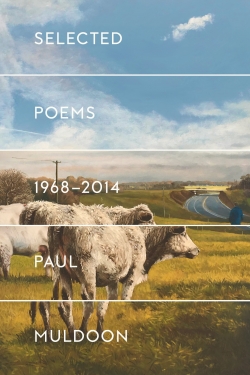Selected Poems 1968–2014
by Paul Muldoon
reviewed by Heather Clark
The cover of Paul Muldoon’s Selected Poems 1968–2014 shows a typically Irish pastoral scene: there is a cow, a green field, a big sky, and a solitary man walking down an empty road. Yet the book’s jacket flap reveals that the painting’s title is “The Dividing Road.” Suddenly the stock images seem, in typically Muldoonian fashion, more ambiguous. Is the “dividing road” the border between Northern Ireland and the Republic of Ireland? Which side is the man walking on, and where he is headed? The painting brings to mind one of Muldoon’s best poems, “Why Brownlee Left”:
Why Brownlee left, and where he went
Is a mystery even now.
For if a man should have been content
It was him; two acres of barley,
One of potatoes, four bullocks,
A milker, a slated farmhouse.
He was last seen going out to plough
On a March morning, bright and early.
Muldoon never reveals why Brownlee left. The “mystery” of his defection stands at the heart of Muldoon’s poetry, which always asks and never tells.
Muldoon himself left his native Northern Ireland for Princeton, where he now teaches, but his poems often contain a backward glance. When he emerged onto the poetry scene in 1970s Belfast, he was ideologically and formally ahead of his time. His hybrid, postmodern vision of Irishness has always tried to reconcile the provincial with the cosmopolitan: he seems to have predicted the present cultural moment in which the Prime Minister of Ireland is of Indian heritage and gay. Yet how does Muldoon’s poetry make a space for itself in the age of celebrity instapoets like Rupi Kaur, whose direct, unambiguous work is antithetical to Muldoon’s oblique pyrotechnics?
Muldoon may be the most dense and difficult of contemporary poets, but his work is full of play, whimsy, and irony. He asks us not to take his poems too seriously even as his language makes serious demands. It is all there in “The More a Man Has the More a Man Wants” (1983), written in spectral sonnets not long after the Republican hunger strikes. Drawing upon Native American folklore, popular culture, and Irish history, the poem rejects tribal sentimentalism and side-taking. Thirty-five years on, it has lost none of its resonance and remains one of the best poems about the Troubles in Northern Ireland. Like much of Muldoon’s work, it transcends the local. The poem might be full of obscurities to a non-Irish reader, yet the ingenuity of the language and the integrity of Muldoon’s anti-sectarian message drive its momentum:
White Annetts. Gillyflowers. Angel Bites.
When he names the forgotten names
of apples
he has them all off pat.
His eye like the eye of a travelling rat
lights on the studied negligence
of these scraws of turf.
A tarpaulin. A waterlogged pit.
He will take stock of the Kalashnikov’s
filed-down serial number,
seven sticks of unstable
commercial gelignite
that have already begun to weep.
Red Strokes. Sugar Sweet. Widows Whelps.
While the compact pieces in Selected Poems are often easier to grasp—favorites like “Cuba,” “Anseo,” and “Meeting the British”—Muldoon included several long, winding poems in this relatively short book. (There are only five poems printed from each of Muldoon’s twelve collections.) The choice suggests Muldoon’s trust in maze-like forms where speakers backtrack and meander, but always seem to come out the other side.
Anyone who thinks Muldoon’s work is out of touch might look to James Joyce, whose legacy has not suffered from lack of clarity. What stands out in Ulysses, now that the allusions have been traced, are the deep currents of sympathy and inclusiveness running through the novel. The same is true of Muldoon’s poetry. We should read these poems for their formal mastery, their improbable yet perfect rhymes, their open gestures, and their hopeful ironies. Muldoon may mock his consolatory vision in his great elegy for Mary Farl Powers, “Incantata,” but he offers it up nonetheless:
I thought again of how art may be made, as it was by André Derain,
Of nothing more than a turn
in the road where a swallow dips into the mire
or plucks a strand of bloody wool from a strand of barbed wire
in the aftermath of Chickamauga or Culloden
and builds from pain, from misery, from a deep-seated hurt,
a monument to the human heart
that shines like a golden dome among roofs rain-glazed and leaden.
The moments when Muldoon’s language seems most hermetic and opaque are also the moments when he rescues language from banality. As Selected Poems shows, Muldoon is one of the most important, inventive, and distinctive poets of the last half-century. He has invigorated not just poetry but English itself. His work still lights the way forward as it did fifty years ago when his teacher, Seamus Heaney, recognized a major talent. These are poems that will never go stale. Who else, after all, would rhyme “far between” and “verboten”?
Published on July 10, 2018

